Railroads in Syracuse, New York
Railroads in Syracuse, New York, were first mentioned in October 1831, when a convention held in the city marked one of the earliest moves to stimulate the era of railroad building which ultimately brought steam railroad service to New York State.[1] At the time of the convention, the oldest railroad in Onondaga County had been in operation for two years.[1]
Out of the convention came the impetus which gave birth to the roads which consolidated in 1853 to form the New York Central Railroad which was a conglomeration of several lines and by the late 1860s, the Delaware, Lackawanna and Western Railroad, another important railroad conglomerate, was also making inroads in Central New York.[1]
Railroads were big business in Syracuse and life in many ways revolved around them with the continuing ease of transportation and proliferation of jobs they brought to the local economy. The first street railway was built in Salina Street in 1859[2] and Syracuse was soon known "far and wide" as the city where the trains passed through the middle of downtown. Travelers caught "intimate glimpses" of the city, its people, stores and houses as the trains slowed on their way through town.[3]
History
At the time of the first railroad convention in Syracuse, in October 1831, the oldest railroad in the State, the pioneer Mohawk and Hudson Railroad had not reached the age of three. This was followed by the incorporation of the Auburn and Syracuse Railroad. At that time, Auburn, New York, was a larger village than Syracuse therefore its name was mentioned first in the company title.[1]

Vanderbilt square
The first railroad station in Syracuse was open for business by early 1839[1] in Vanderbilt Square, along East Washington Street between Salina and Warren Streets and was named for Commodore Cornelius Vanderbilt, a railroad magnate and millionaire whose New York Central Railroad "dominated Washington Street for 100 years."[4]
Railroads were such a dominant form of transportation in those days; the square was perpetually coated with soot from the locomotives running down tracks in the middle of the street.[4] The new station had doors at either end which were closed after the arrival and departure of the trains.[1]
From 1839 on, Syracuse life for many years revolved around Vanderbilt Square, the magnet was the railroad station, and the hostelries that grew up around it. In the old station, Henry Clay was welcomed on his visit to the New York State Fair in 1849. Daniel Webster, General Winfield Scott, Louis Kossuth, John Brown, Stephen A. Douglas, and other notables were greeted there.[1]
A resolution Elias W. Leavenworth, mayor of Syracuse introduced in 1888 procured Vanderbilt Square as a park for the city. Additionally he persuaded the railroad to plant rows of trees on each side of the railroad from Beech Street to the heart of the city and install the first public sewer.[5]
Abraham Lincoln visits
Inauguration
Abraham Lincoln passed through Syracuse twice. The first trip, which occurred on February 18, 1861, was a very joyous occasion filled with "gaiety and excitement" as he had just been elected to the Presidency of the United States and was en route to his inauguration in Washington, D.C.. His train arrived in the city that afternoon a little ahead of schedule. Its arrival was announced by a "booming cannon" of the Washington Artillery, fired at Regiment Park, while the Regimental Band played The Star Spangled Banner. The train was composed of a gaily decorated engine, baggage car and two coaches which were filled with the Presidential entourage and various committees representing cities along the Central Road.[6]
The city of Syracuse flag and Union flags were suspended across the railroad tracks and Salina Street, both north and south of the depot. For many hours before the arrival of the train, throngs of people gathered on Salina Street, the main street through the city, and flooded Vanderbilt Square. As the train came to a halt, it was "engulfed by a huge crowd." Four military companies marched in and after much shoving from the "good-natured crowd," were able to clear a small area for reporters and committeemen, "while an immense and swaying mass of humanity surrounded them on all sides."[6]
Lincoln, accompanied by Mayor Westcott, stepped onto the rear platform of the train where he was greeted "by a thunderous cheer" and the mayor welcomed him to Syracuse. Lincoln replied that he had observed the city had erected a platform for his use, but his stay would be very brief and the fatigue of his long journey was very great and hoped that would not be regarded as meaning he would never stand upon another platform, erected in another place. He remarked that an intelligent and happy crowd had assembled to welcome him and he could do nothing more than greet them and bid them farewell with the hope that our country would continue to prosper forever.[6]
At the conclusion of his remarks, Captain Titus of the Washington Artillery called for three cheers for the President, "which were given heartily and three rousing cheers for the Union." Lincoln then remarked that it was impossible for him to shake the hands of all his friends, but he did shake the hands of as many as possible.[6]
As the train passed slowly off, Lincoln remained on the platform and bowed to the people assembled on each side of the track, giving everyone an opportunity to see him distinctly.[6]
Funeral procession
Lincoln's second trip through Syracuse during April 1865, in his funeral procession was one of the most solemn and impressive events in the city's history. Over the same route that carried Lincoln to the White House, "he would return on this, his final journey home."[6]
In downtown Syracuse the old station, which covered Vanderbilt Square, was "elaborately and appropriately decorated" both inside and out. Festoons of black and white hung from the east and west gables and flags were draped from both sides of the building. As early as "eight o'clock" in the evening, the station was overflowing with people eager to see the remains of the martyred President.[6]
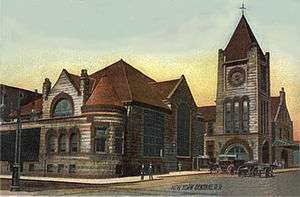
The Hon. Charles B. Sedgwick delivered a Eulogy on the life and services of the President at 8:00 pm on April 24, 1865, in Hanover Square.[7]
The funeral train reached Syracuse at midnight, April 25, 1865. As soon as the train emerged from the tunnel in the eastern limits of the city, "minute guns" were fired and the bells of the Syracuse City Hall and all the churches "tolled in requiem."[6]
Since the schedule allowed the funeral train to stop for no longer than 30 minutes, only a few thousand people passed through the funeral car. A band played dirges in "mumbled tones" and a three-year-old girl laid a bouquet on the coffin as her tribute of respect. The coffin lay on blocks 6-inch (150 mm) in height. Festoons of black cloth hung from the sides, "bespangled with silver stars and edged in silver bullion." The upper lid of the coffin was laid back so as to reveal the head and bust of the late President. Lincoln's face seemed to retain all the dignity and strength of life. "The lines of his grave countenance were unchanged, and his eyes were those of one in peaceful slumber."[6]
The train left the city at 12:30 am. A special "pilot train" ran 10 minutes ahead and no train was permitted to run within 20 minutes of either of these trains. The houses and buildings along the line of track to the western limits of the city were illuminated and draped with mourning emblems. The church bells continued to toll and the minute guns continued to fire until the remains of the President were borne outside the city and headed west through village of Jordan on the way to the funeral in Springfield, Illinois.[6]
New York Central station

The first New York Central Railroad (NYC) station was erected in the middle of Vanderbilt Square, between Salina and Warren Streets in 1839.[8]
The original station was demolished in February 1870,[2] and a new depot was built on Franklin and West Fayette Streets at the edge of Armory Square. The second NYC station was in use until 1895 when a third station was constructed at the same location on Franklin and West Fayette Street.[8]
The first office in the new station was opened on August 1, 1895 and the station itself was opened for business on October 6, 1895.[9]
Major renovation of the third station took place in 1910, which included the installation of a "huge electric sign" placed at the corner of Franklin and Fayette streets. The company spent several hundred dollars in order to widen the Fayette Street entrance 2 feet (0.61 m) and add concrete steps. Additionally, three "good sized" private offices were converted into a large waiting room with new maple floors, decorations, steel ceilings and comfortable seating. A hole was cut through the back partition for a ticket window and plate glass windows were installed in the main waiting room and an "electric light sign" was placed in the corner. A lavatory for women was added just off the waiting room and the room formerly used for a waiting room in the back corner was converted for storage purposes.[10] The third depot was demolished in 1936.[8]
Passenger and freight station
The fourth NYC station at 815 Erie Boulevard East was built in 1936 in Art Deco design when the tracks were elevated above city streets. Both the station and the new elevated route opened for business on September 24, 1936. After the railroad tracks behind it were converted into Interstate 690 in 1968, the building became the Greyhound bus station. In 1998, Greyhound left for the William F. Walsh Regional Transportation Center on the north side of the street, at 131 Alliance Bank Parkway. Time Warner bought the building and brought back its former elegance, reopening it in 2003. By July 2009, the facilities were home to Time Warner's News 10 Now.[8]
The building is known as the New York Central Railroad Passenger and Freight Station.[11]
Railroads
Syracuse prospered in the early days due to its central location and the availability of several modes of transportation. The area had ready access to many railroads as well as the Erie Canal. The railroads were big business in Syracuse during those growth years.[12]
As late as 1863, horse drawn lines were still considered a viable form of transportation. The Oakwood and Geddes lines were built that year. Later, steam locomotives replaced the horse drawn lines.[2] The list of railroads is in chronological order.
Auburn and Syracuse railroad

The Auburn and Syracuse Railroad was incorporated in 1834 to provide easy access to and from Syracuse and the Erie Canal. Construction was begun in 1835; however, was delayed during the Panic of 1837. Although the economic downturn lingered until 1843, the railroad was completed by January 1838.[13]
Syracuse railroad "subscribers" contributed $31,000 to the $400,000 stock authorized in the incorporation articles received on May 1, 1834. Among the 20 investors was Vivus W. Smith, who later was one of the founders of the Syracuse Journal daily newspaper.[1]
The road was opened for business on January 8, 1838, with horse-drawn trains. On June 4, 1839, the first locomotive owned by the line, the Syracuse, traveled the wooden rails and pulled the first train by steam. By 1839, one of the trains achieved the 26 miles (42 km) run in 58 minutes. A year later, in 1840, the event was reported in the Western State Journal.[1] Known as the Auburn road the company erected a new depot between Salina and Clinton streets in late 1838.[14]
The depot was replaced that next summer in 1839 when the depot of the Syracuse and Utica Railroad was ready for use. The depot of the Auburn road was not known for either beauty or finish, presenting a "striking contrast to its majestic neighbor across the street."[14]
Only after the advent of the steam railroad did that mode of transportation finally arrive in Syracuse. Originally, a mill pond on the site of the State Armory, located at the present day Armory Square, in West Jefferson Street, blocked the right of way. It was not until a trestle was built across the pond, that passengers were no longer "forced to find other means" of getting into the village of Syracuse from a temporary station at Geddes. Work on the trestle was completed in early 1839 as well as construction of a new railroad station in Downtown Syracuse.[1]
In August 1850, the Auburn and Syracuse Railroad joined the Auburn and Rochester Railroad to form the Rochester and Syracuse Railroad, which later merged with the New York Central Railroad.
Syracuse Stone railroad
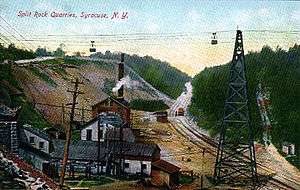
The Syracuse Stone Railroad, incorporated in Syracuse on May 13, 1836,[15] was granted approval by the State to build a road from the city proper to local quarries in Onondaga, New York, located southwest of the city.[16]
The road was chartered on the same day as the Syracuse and Onondaga Railroad which was organized for the same purpose and completed on October 16, 1838. The Syracuse Stone Railroad was abandoned before construction was even started and was consolidated into the Syracuse and Onondaga Railroad.[17]
Syracuse and Onondaga railroad
The Syracuse and Onondaga Railroad was chartered in Syracuse on May 13, 1836, and[15] was granted approval by the State to build a road from Syracuse to local quarries in Split Rock, New York.[16] The road was incorporated on the same day as the Syracuse Stone Railroad which was organized for the same purpose. Both roads were consolidated before the construction of the road was complete on October 16, 1838.[17]
The small railroad joined with the Auburn and Syracuse Railroad from Geddes into the city proper and the depot at Vanderbilt Square in Downtown Syracuse.[1]
Syracuse and Utica railroad
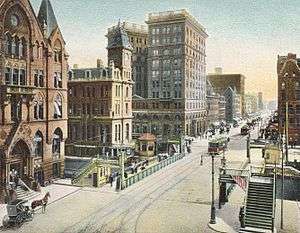
A second railroad was organized along a route from Syracuse to Utica. The route went through Oneida and Rome, a distance of 53 miles (85 km). On July 1, 1837, the village of Syracuse gave consent to a right of way along Washington Street for the railroad. The station in Vanderbilt Square was used by this railroad as well as the Auburn and Syracuse Railroad.[1]
John Wilkinson, first postmaster of the village of Syracuse, who had given the village its name from the title of a poem, was president of the Syracuse and Utica Railroad. Vivus Smith served as the first secretary. As a result of their efforts, the railroad was headquartered in Syracuse instead of Utica, providing the village with an important industry.[1]
Daniel Elliott was the architect and builder of the Syracuse and Utica Railroad depot which was a "striking exhibition of architectural skill and beauty." The depot was occasionally used for political or village meetings and public addresses. Noted characters were frequently received there including Martin Van Buren, Henry Clay and Gerrit Smith. At first, the building served its purpose very well, but soon became too cramped for convenience and the offices were "one by one removed to other quarters near by," where they remained until a new depot was constructed on Franklin Street.[14]
Wilkinson, as president, ordered the construction of the first "flat car" for the line after passengers complained they needed a car in which they could carry purchases made in Syracuse back to Utica. This was the first "so-called" freight car in the nation, the forerunner of the modern freight business.[1]
The railroad celebrated its first public run on July 4, 1839.[1] The company installed their tracks along Washington Street where the New York Central Railroad retained the right-of-way.[3] They merged with New York Central Railroad in 1853.[18]
Oswego and Syracuse railroad
The Oswego and Syracuse Railroad was formed April 29, 1839, and the route was surveyed during the summer of that year. The company was fully organized March 25, 1847. The road was opened on May 14, 1848, and ran a total distance of 35.5 miles (57.1 km) from Syracuse to Oswego, New York, northwest of the city.[19]
The company consolidated with the Syracuse, Binghamton and New York Railroad in 1853 after the act was authorized by the New York State Legislature.[15] In 1872, the rail passed under the management of the Delaware, Lackawanna and Western Railroad.
Syracuse and Binghamton railroad
The Syracuse and Binghamton Railroad was established in 1851 and opened for business in 1854.[1] The road merged in 1856 into Syracuse and Southern Railroad which was renamed to Syracuse, Binghamton and New York Railroad when the company reorganized after foreclosure in 1857.[19] The road was linked to the earlier Oswego and Syracuse Railroad line shortly after both came under control of the Delaware, Lackawanna & Western Railroad in 1869. This was accomplished despite difficulties caused by the use of wide gauge rails by one railroad and standard gauge by the other.[1]
The railroad brought coal from the Pennsylvania mines to be used as fuel in the salt fields. The salt industry had another able champion in Thomas G. Alvord, whose efforts in its defense at Albany, New York, earned him the nickname of Old Salt. He was elected to the assembly in 1845 and became lieutenant governor of New York State in 1864.[3]
Direct railway
The Direct Railway Company was incorporated in 1848 and was designed as a direct route between Syracuse and Rochester and reduced the total trip by 23 miles (37 km) as opposed to the Auburn and Rochester Railroad which was designed to provide local service to villages along the way, therefore a less direct route.[1]
The Rochester and Syracuse Railroad Company, incorporated in 1850, were granted authorization to construct a direct route line and acquire all rights of the direct line. The charter also authorized the consolidation of the Auburn and Rochester Railroad Company and the Auburn and Syracuse Railroad Company.[20]
The Direct Railway opened for business in June 1853, two months before the formation of the New York Central Railroad (NYC)[1] and were consolidated with NYC in 1853.[18]
Rochester and Syracuse railroad
The Rochester and Syracuse Railroad Company was incorporated on August 1, 1850, and were granted authorization to construct a direct route line and acquire all rights of the Direct Railway Company. The charter authorized the consolidation of the Auburn and Rochester Railroad Company and the Auburn and Syracuse Railroad Company.[20]
The merger also involved the acquisition of all the rights and property of the Direct Railway Company, established in 1848, between Syracuse and Rochester and the construction of that road as a part of the consolidated road.[20]
The railroad was consolidated with NYC in 1853.[18]
Delaware, Lackawanna and Western railroad

The Delaware, Lackawanna and Western Railroad Company was incorporated in 1853. During the late 19th century the road merged with several small railroads in Central New York including Oswego and Syracuse Railroad (1839–1872), Syracuse and Binghamton Railroad (1851–1869) and Syracuse and Baldwinsville Railroad (1886–1891).
As a result of the Delaware, Lackawanna and Western Railroad (DLW) buying the Syracuse, Binghamton and New York Railroad in 1869 and leasing the Oswego and Syracuse Railroad that same year, the company gained a branch from Binghamton north and northwest via Syracuse to Oswego, a port on Lake Ontario.
The Syracuse and Baldwinsville Railroad was established in 1886 and ran a distance of 6 miles (9.7 km) from Baldwinsville to Amboy, New York.[19] In 1886, DLW bought the road and it was renamed to Syracuse and Baldwinsville Railway in 1891.[21]
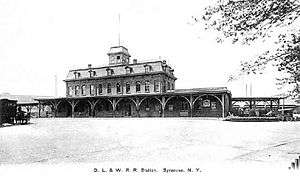
During 1908, Lackawanna Railroad superintendent in Syracuse was G. A. Poore. J. L. Smith was the division passenger agent and W. S. Cummings was city ticket agent. The division freight agent was J. J. Byrne who worked at the freight depot located at 124 East Washington Street. J. L. Cobb was depot ticket agent at the passenger depot at 225 West Jefferson Street where G. Clinton Ferris was train master and Rockwell M. Skeele was chief train dispatcher. The freight office was located at 144 South West Street where Zenas Eldred was agent and time inspectors were Stetson & Crouse.[22]
By September 1926, the Lackawanna Railroad introduced the Whitelight Limited which was touted as a "radical improvement in night trains with faster times and better schedules." The line ran from New York City to Syracuse and had drawing room sleeping cars for Syracuse, Ithaca, Elmira and Buffalo departing from New York City with "assured connections" at Broadway and Hudson Terminal at 11:23 pm and arriving in Syracuse at 7:35 am.[23] Later, the DLW would run a route, from different points to the south, such as Binghamton and Philadelphia, as the Interstate Express.
During March 1936, work had begun on the Geddes Street underpass in Syracuse at the intersection of Erie Boulevard on the Far Westside. The crossing was owned by DLW and at the time it was one of the most dangerous in the city. The new underpass eliminated the need for the crossing.[24]
Syracuse and Utica Direct railroad
In 1852, a rival company to the Syracuse and Utica Railroad, called the Syracuse and Utica Direct Railroad, threatened to build a line from Syracuse to Utica by a more direct route, by way of Vernon. This reduced the total travel time from four hours to three and one-half hours.[1]
It was at this time that the Syracuse and Utica Railroad decided to "double track its line through Washington Street."[1] The Syracuse and Utica Direct Railroad merged with New York Central Railroad in 1853.[18]
New York Central railroad

The New York Central Railroad (NYC) was a railroad operating in the Northeastern United States. Headquartered in New York City, the railroad served most of the Northeast, including extensive rail lines in the states of New York, Pennsylvania, Ohio, Michigan, Indiana, Illinois and Massachusetts, plus additional lines in the Canadian provinces of Ontario and Québec. Its primary connections included Chicago and Boston. The NYC Grand Central Terminal in New York City, is one of its best known landmarks.[12]
The Water Level Route of the NYC, from New York City to Upstate New York, was the first four-track long-distance railroad in the world.[12]
The merger of seven railroads in Central New York was foreshadowed as early as 1842 when completion of a line between Buffalo and Attica made it possible to travel between Buffalo and Albany, with a change necessary only at Rochester.[1]
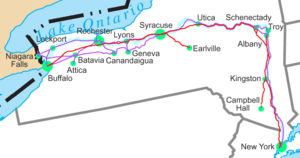
On January 31, 1843, the seven railroad companies operating along the route met in Albany and agreed to run two "through" trains daily between the Hudson River and Lake Erie terminals. The trip took 25 hours and cost $11.50 for first class. Average speed on the 326 miles (525 km) run was 13 miles per hour (21 km/h).[1]
Some consolidation of these roads had been effected by April 2, 1853, when the New York State Legislature passed an act authorizing the merger of any or all the ten railroads organized on routes between the Hudson River region and the Great Lakes. By July 7, 1853, an agreement had been reached by the "ready" railroad directors. This was the beginning of the growth of the New York Central Railroad which eventually spread westward from Buffalo and moved to New York City by the Hudson River Line.[1]
The Syracuse, Rochester and Buffalo divisions of the company were run individually and each "seemed to be a separate railroad." The Syracuse Division operated the main line west from Syracuse to Wenda a few miles east of Depew, a suburb of Buffalo. There were only two major four-track main lines in the country, and the NYC had one of them. The division consisted of the four-track main line, a single-track West Shore and a "few minor branches" such as the Chenango Branch through Fayetteville and Manlius to Cazenovia and Earlville, New York. Additionally, the Fall Brook from Lyons, New York to Corning, the terminal area in Syracuse and the DeWitt yards.[25]

The NYC in Central New York was a conglomeration of several lines in chronological order including Auburn and Syracuse Railroad (1834–1850), Syracuse and Utica Railroad (1836–1853), Syracuse and Utica Direct Railroad (1848–1853), Rochester and Syracuse Railroad (1850–1853), Syracuse and Utica Direct Railroad (1853-1853), Syracuse, Chenango and New York Railroad (1868–1883), Syracuse and Northern Railroad (1868–1875), Syracuse, Phoenix and Oswego Railroad (1871–1889), West Shore Railroad (1872–1885), Syracuse Junction Railroad (1873–1875), Syracuse Northwestern Railroad (1874–1875), Syracuse, Geneva and Corning Railway (1875–1909) and Syracuse, Ontario and New York Railway (1883–1891).[1]
In 1894, the New York Central & Hudson Railroad had their city office in Vanderbilt Square at 127 East Washington Street. General manager was F. J. Wolfe and city passenger agent was W. E. Brown. The company advertised they were the only railroad with a depot in New York City and touted their "great four-track route to New York, Boston and Chicago and all points east and west."[26]
By November 1907, the time table of the New York Central showed 166 trains a day out of Syracuse, both east and west bound.[27]
During 1908, the company was known as New York Central and Hudson Railroad and shared their passenger depot located on South Franklin Street at the corner of West Fayette Street in Syracuse with West Shore Railroad. They also shared some employees such as freight agent, J. C. Ewers and depot master, C. F. McCoy. Additionally, Seneca Kelley was division freight agent, O. E. Jenkins was district passenger agent and city ticket agent was E. M. Brodock. The main office was located in Downtown Syracuse in University Block where superintendent was F. W. Everett and general superintendent was L. H. VanAllen and depot master was W. D. Barton at the S. A. & K building. Supervisor tracks was H. H. Lincoln and depot ticket agent was Louis Bluestone.[22]
The Rome, Watertown and Ogdensburg Railroad, was a lessee of the company and their Syracuse Division also shared the main passenger depot. Their freight depot was located at 100 West Belden Avenue. General agent at the passenger depot was W. H. Northrup. They also shared employees including depot ticket agent, Louis Bluestone, district passenger agent, O. E. Jenkins and agent J. C. Ewers. City ticket agent was J. B. Peck located at University Block.[22]
In June 1920, the total value of the New York Central Railroad franchise in Syracuse as determined by the New York State Tax Commission was $871,920, up from $848,094 in 1919.[28]
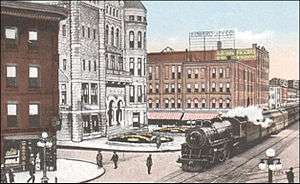
Empire State Express
The Empire State Express was one of the named passenger trains and onetime flagship of the New York Central and Hudson River Railroad (a predecessor of the modern New York Central Railroad). It became the world's first high-speed passenger train on September 14, 1891, when it covered the 436 miles (702 km) between New York City and Buffalo in just 7 hours and 6 minutes (including stops).[29]
 New York Central & Hudson Railroad - Vanderbilt Square - 1894 |
 New York Central Railroad - Advertisement "Excursion Fares" - Syracuse Post-Standard, July 14, 1910 |
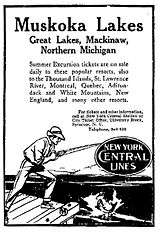 New York Central Railroad - Advertisement "Moskoka Lakes" - Syracuse Post-Standard, July 2, 1912 |
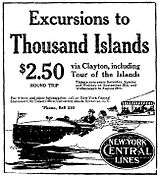 New York Central Railroad - Advertisement "Thousand Islands, New York" - Syracuse Herald, July 12, 1912 |
 New York Central Railroad - Advertisement "Florida Sunshine" - January 23, 1917 |
Syracuse, Chenango and New York railroad
The Syracuse and Chenango Valley Railroad, with routes through the Chenango Valley, founded in 1868,[1] was renamed to Syracuse and Chenango Railroad in 1873 and once again to Syracuse, Chenango and New York Railroad[19] in 1877. In 1883, they were merged into Syracuse, Ontario and New York Railway and by 1891 became part of West Shore Railroad which merged with NYC in 1885.
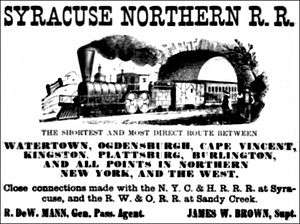
Syracuse and Northern railroad
The Syracuse Northern Railroad Company was chartered on February 25, 1868, and opened for business on November 9, 1871,[30] with routes to Watertown, New York. In 1875, the rail was extended to Pulaski and Lacona.[31] The company was sold under foreclosure and reorganized as the Syracuse and Northern Railroad Company in 1875 and consolidated that same year into Rome, Watertown and Ogdensburg Railroad.[19]
In 1913, the Rome, Watertown and Ogdensburg Railroad became part of New York Central and Hudson River Railroad which reverted to NYC in 1914.
Syracuse, Phoenix and Oswego Railroad
The Syracuse, Phoenix and Oswego Railroad was chartered on November 29, 1871, and had a route from Woodard, located north of Syracuse to Fulton, New York, a distance of 17.11 miles (27.54 km).[19] They merged with the Syracuse Northwestern Railroad on June 10, 1875, and incorporated as Syracuse, Phoenix and Oswego Railway on February 16, 1885.[19]
In 1889, the railroad line merged with Rome, Watertown and Ogdensburg Railroad until 1913 when the company became part of the New York Central and Hudson River Railroad which was renamed to New York Central Railroad in 1914.
West Shore railroad
The West Shore Railroad was organized in 1872 and built in 1874 to connect New York City with Buffalo and compete with the New York Central Railroad (NYC). The line was extended to Buffalo by 1884.[32] A rate war led to the demise of the road, which was leased to the NYC in 1885.[1]
A second line, called the New York, West Shore and Buffalo Railway Company was incorporated on June 14, 1881,[32] and secured its franchise in Syracuse later that same year, and was opened for business on October 1, 1883.[2]
During 1908, the railroad shared the New York Central and Hudson River Railroad passenger depot located on South Franklin Street at the corner of West Fayette Street in Syracuse. It also shared some employees such as freight agent, J. C. Ewers and depot master C. F. McCoy. Additionally, H. H. Lincoln was supervisor of tracks, Seneca Kelley was division freight agent, O. E. Jenkins was district passenger agent and city ticket agent was E. M. Brodock. The main office was located in Downtown Syracuse in University Block. The Chenango Branch of the road also shared the passenger depot.[22]
In June 1920, the total value of the West Shore Railroad franchise in Syracuse as determined by the New York State Tax Commission was $353,120, up from $330,672 in 1919.[28]
Syracuse Junction railroad
Syracuse Junction Railroad was established on June 9, 1873, by the New York Central and Hudson River Railroad Company in order to route two freight tracks of its four track system around the city of Syracuse. The line opened for business on November 16, 1874. It was leased back to the New York Central and Hudson River Railroad Company on April 10, 1875, as a legal formality and was absorbed under authority of law on April 10, 1875, and changed to New York Central Railroad in 1914. By 1950, the line was still in use and routed through the Carrier Corporation plant in Syracuse where air conditioners were loaded and shipped.[33]
Syracuse Northwestern Railroad
The Syracuse Northwestern Railroad was chartered on September 19, 1874, and merged in 1875 with Syracuse, Phoenix and Oswego Railway which was established in 1871. The company was renamed to the latter on June 10, 1875, and reorganized on February 16, 1885. The railroad line ran from Woodard, located north of Syracuse to Haymarket Square in the city.[19] In 1889, the combined railroad line merged with Rome, Watertown and Ogdensburg Railroad until 1913, when the company became part of the New York Central and Hudson River Railroad which was renamed to New York Central Railroad in 1914.
Syracuse, Geneva and Corning railway
The Syracuse, Geneva and Corning Railway Company was chartered on August 27, 1875, and opened their road on December 10, 1877. The company was leased to and operated by the Fall Brook Coal Company for 20 years beginning in 1881.[34]
On October 1, 1885, the company consolidated without a change of name to a road in Penn Yan, New York,[19] and the property was eventually leased to the New York Central and Hudson River Railroad Company beginning on May 1, 1899.[34] During 1914, the company was merged into New York Central Railroad.
Syracuse and Baldwinsville railroad
The Syracuse and Baldwinsville Railroad Company was chartered on June 2, 1886, and opened on January 1, 1887. The line ran a distance of 6 miles (9.7 km) from Baldwinsville to Amboy. F. F. Bentley was the receiver and general manager. He was from Baldwinsville where the company was headquartered.[19]
In 1886, Delaware, Lackawanna and Western Railroad (DLW) bought the road and it was renamed to Syracuse and Baldwinsville Railway in 1891. DLW formally abandoned the line in 1897.[21]
Syracuse, Ontario and New York railway
The Syracuse, Ontario and New York Railway Company was established in 1883 after it was formed from the Syracuse, Chenango and New York Railroad Company. Beginning on July 1, 1890, it operated as the Chenango County, New York, branch of the West Shore Railroad. On April 2, 1891, the railroad and property of the Syracuse, Ontario and New York Railway Company were formally leased, for the term of its corporate existence, to the West Shore Railroad Company on June 30, 1891.[35] Later, ownership was transferred to the New York Central Railroad.[35]
All of the officers were from New York City where the company was headquartered at 5 Vanderbilt Avenue. The road master in Syracuse was D. E. Dale and J. J. Farrell was auditor.[19]
Penn Central railroad
In 1968, the NYC merged with its former rival, the Pennsylvania Railroad to form Penn Central. The merged railroad line ran through fourteen states and two Canadian provinces.[36] The New York, New Haven and Hartford Railroad joined in 1969 as mandated by the Interstate Commerce Commission.[37] Penn Central declared bankruptcy in June 1970[37] and was taken over by the federal government and merged into Conrail on April 1, 1976.[37]
Amtrak
Amtrak was created on May 1, 1971, as the National Railroad Passenger Corporation to assume the passenger operations of private railroads which had been declining since the 1950s. In Central New York, Amtrak's Empire Corridor Service extends from Penn Central Station in New York City up the Hudson River Valley to Albany, and west through Syracuse to Niagara Falls. It also includes the segment from Albany to Montreal along Lake Champlain utilizing the Delaware and Hudson Railroad (CP Rail).[37]
From Albany west, the corridor serves Schenectady, Amsterdam, Utica, Rome, Syracuse, Rochester, Buffalo and Niagara Falls.[37]
New York, Susquehanna and Western railroad
The New York, Susquehanna and Western Railroad (NYS&W) is a regional carrier with over 400 miles (640 km) of track in New York, New Jersey and Pennsylvania. The company started service in the Syracuse Metropolitan Area in the early 1980s. The former Delaware, Lackawanna and Western Railroad line from Syracuse to Binghamton was proposed for abandonment by Conrail and subsequently taken over by the NYS&W in 1982.[37]
Conrail maintained the portion of the line from Jamesville to Syracuse and interchange of freight traffic with the NYS&W took place at Jamesville. In 1993, the Jamesville Secondary Track, which was the 9 miles (14 km) segment from Jamesville to a connection with the Conrail main line in Syracuse, was put up for sale. As part of an effort to begin a passenger shuttle service, Conrail agreed to convey the property to the County Industrial Agency (IDA), which leased it to the Syracuse, Binghamton and New York Railway (SB&NY), a subsidiary of Delaware Otesgo, the parent company of NYS&W.[37]
The railroad also had track rights over the Norfolk Southern (NS) to Buffalo, New York. The range of commodities in transport included feed ingredients, lumber and other building materials, chemicals and aggregates for customers in New York State.[37]
The Syracuse Main Line runs 73.4 miles (118.1 km) from Binghamton to Jamesville, where the freight line is the former Delaware, Lackawanna and Western Railroad Syracuse Branch which continued north to Oswego. South of the city, the line traverses Jamesville, Tully, Cortland and Binghamton.[37]
Syracuse, Binghamton and New York Railway
The Syracuse, Binghamton and New York Railway (SB&NY), a subsidiary of New York, Susquehanna and Western Railroad, was formed as a non-union operation to run the track from Jamesville through Armory Square to Carousel Center. The SB&NY runs a total distance of 10.15 miles (16.33 km). The rail line from Jamesville to Brighton Avenue in Syracuse is primarily undeveloped rural property. From Brighton Avenue north, the line traverses local neighborhoods until passing Syracuse University platform at Raynor Avenue, and passing under Interstate 81 into the Central Business District. Land use within the city limits is a mix of residential, commercial, retail and light industrial.[37]
Conrail
In 1993, Conrail opened a significant new intermodal terminal in DeWitt, New York, to "capture additional traffic moving by truck." This terminal replaced smaller terminals in Rochester, Buffalo and Albany.[37]
Conrail was disbanded in 1998, and much of its system was transferred to the newly formed New York Central Lines LLC, a subsidiary of CSX. That company's lines include the original NYC main line, but outside that area it includes lines that were never part of the original system.[12]
In 1999, Conrail was jointly purchased by the Norfolk Southern Railway (NS) and CSX which split its assets between the two companies. All Conrail lines in Central New York were purchased by CSX. There were also two other companies operating the former Conrail lines; the New York, Susquehanna and Western Railway (NYS&W), and the Finger Lakes Railway (FGLK). Although both new companies were primarily in freight service the NYS&W operated a passenger shuttle in the city known as OnTrack and the FGLK operated occasional shipper specials and excursions.[37]
CSX Transportation
CSX Transportation (CSXT) is the only Class 1 freight railroad in the Syracuse Metropolitan Area. CSXT is part of the CSX Corporation family of transportation companies operating worldwide. On June 1, 1999, CSXT began operating Conrail lines when it purchased 40 percent of the company.[37]
CSXT operates 23,297 miles (37,493 km) in 23 states, the District of Columbia and two Canadian provinces. It is the largest rail network in the northeast United States and owns 1,333 miles (2,145 km) in New York State. The key commodities it transports include automotive, grain, food products, paper and chemicals.[37]
CSXT corridors
The Mohawk Subdivision (Chicago Main Line) utilizes the New York Central Railroad (NYC) main line track as its primary route between New York, Boston and Chicago. Traffic consists of approximately 70 freight trains per day with eight daily Amtrak trains. Track 1, on the northside is primary westbound traffic and Track 2, on the south side, is eastbound traffic. From east of Syracuse to Belle Isle, near the New York State Fair, Track 1 carries 69 percent of the tonnage. Moving west through Central New York, the line traverses Kirkville and DeWitt before making a loop around the city on the old New York Central Railroad freight by-pass.[37] The main tracks cross over Park Street at the site of the William F. Walsh Regional Transportation Center past the Carousel Center and traverse the rear of the New York State Fairgrounds.[37]
The St. Lawrence Subdivision, a former New York Central Railroad secondary line, is a single-track railway that runs 158.8 miles (255.6 km) from the Chicago Main Line near Carousel Center to the junction at Massena with the Canadian National Railway (CN) to Montreal. The portion from the Chicago Main Line to Watertown is 70 miles (110 km). On that section there are two controlled passing sidings; one at Control Point Woodard (CP W) north of Liverpool within the Woodard Industrial Park, and another at Pulaski. The line serves Clay before traversing north to Parish and points beyond. In Liverpool, the tracks skirt the living history museum at St. Marie de Ganathaha and adjacent parklands on Onondaga Lake Parkway. The track is abutted on both sides by residential areas. North of Liverpool to Woodard is primarily industrial with some adjacent resident property, and beyond Woodard to Brewerton is primarily rural woodlands and mixed residential.[37]
The Fulton Subdivision is a single-track line that runs 25.8 miles (41.5 km) from the Montreal Subdivision at Woodard, north of Liverpool to Oswego, serving customers in Phoenix and Fulton on the east side of the Oswego River, formerly the old NYC line.[37]
The Baldwinsville Subdivision is a single-track line that runs to Oswego. From the Mohawk Subdivision (Chicago Main Line) near the New York State Fairgrounds, the track is considered the Fairgrounds Subdivision and runs a distance of 34.7 miles (55.8 km). This is the northern section of the former Delaware, Lackawanna and Western Railroad line to Oswego. The southern end of the line is operated by the New York Susquehanna and Western Railroad. After it leaves the Chicago Main Line, the line traverses heavy industrial land for a short stretch before passing the main gate of the New York State Fairgrounds. The line next passes mixed residential and light industrial until past John Glenn Boulevard in the town of Salina. North of that point, the land use is primarily rural woodlands and increasing residential development as far as Baldwinsville, beyond which, the surrounding land use is rural woodlands.[37]
DeWitt Yard
The DeWitt Yard of the Syracuse Division was the largest in New York and more trains were attended here than any other yard in the state.[25] The yard was first conceived in 1853 when the Syracuse Utica Railroad line became part of the New York Central Railroad system and was a major contributor to the development of the village of East Syracuse. In 1872, due to continued growth of traffic in the region, the area called Messina Springs was purchased by the railroad to establish the DeWitt Yard.[37]
The gate to the yard on the east was at Kirkville at Tower 44 on the Mohawk Division. At that point, the passenger and freight tracks split and the freight rails ran into DeWitt, while the passenger tracks continued on to Midler Avenue and from there to the elevated railway. Next, the road joined the Syracuse Junction Railroad in Solvay, where both lines intersected again. The west gate was at Clark Street in East Syracuse. The freight tracks "skirted" the northern edge of the city.[25]
The area west of Tower 2 at Syracuse Junction in Solvay reverted to a four-track main line. At this point, the Auburn Road traveled southwest through Camillus. From there, tracks ran east to Geddes Street, the route of the original railroad until 1936. Tracks also ran east to the Salina Yard which was the original site of the Rome, Watertown and Ogdensburg Railroad facilities when that line was a separate road. This is the current site of the Carousel Center.[25]
In 1904, the yard was expanded to include two hump facilities. In the 1920s and 1950s, the NYC again enlarged and improved the yard. In the mid-1960s, NYC made a decision to make Selkirk near Albany the main yard and began a process of "downgrading" DeWitt Yard. Traffic continued to dwindle into the 1980s and in January 1991, Conrail closed the hump classification operation. The yard remained open, however, the eastbound yard was relegated to storage of freight cars and maintenance-of-way equipment and the formerly active classification yard was limited to storage of freight cars.[37]
In July 1933, the economy was beginning to revive after the Great Depression and the company promoted 18 firemen running out of the DeWitt yards to engineers. It was announced they would start as freight engineers and replace freight engine drivers who had been promoted to the passenger service. It also resulted in the hiring of 18 new firemen and additional brakemen and other trainmen were needed to "man the new trains."[38]
In 1993, Conrail opened a new truck/rail intermodal facility in the DeWitt Yard. Under CSX Transportation (CSXT) auspices, it has grown to be the largest intermodal yard in New York State and generates 70,000 lifts/year.[37]

Elevated railway
Congestion grew in the city as both the Delaware, Lackawanna and Western Railroad (DLW) and the New York Central Railroad (NYC) had tracks that utilized city streets. This, combined with the fact there were a bevy of trolleys, automobiles, horses, bicycles and pedestrians on the city roadways, a solution needed to be found. Several studies were conducted and in 1927, a decision was made to elevate the railroad through the center of the city.[37]
The NYC elevated its line in 1936 in a major undertaking to remove their tracks from the streets. The DLW completed their elevation project by 1943.[37]
During the 1930s, the city's fourth railroad station was constructed along Erie Boulevard East when the rail line through Syracuse was elevated. In Syracuse, the trains ran through the center of downtown, along Washington Street. That elevated section later was abandoned and replaced by Interstate 690.[8]
In 1963, the New York Central Railroad abandoned their elevated right of way through the city, which became the roadbed to Interstate 690, and removed their station to a smaller facility in the DeWitt freight yards. The New York Central Railroad and successor company, Penn Central, utilized the new facility until 1971 when Amtrak took over.[37]
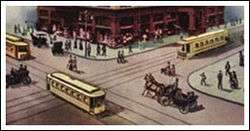
Interurban and streetcar railway
Interurban and Streetcar railway in Syracuse, New York flourished in the city until the automobile, airplane and bus took their place.
The trolley or streetcar served travel within the city limits of Syracuse as early as 1859. In the early days they were either horse-drawn or fueled by steam and by the end of the 19th century they were electric driven. The city was one of the first in the United States to adopt electricity as a transportation motive power.[39]
Interurbans were suburban railways with rights-of-way for higher speed traffic. They linked the city with the countryside[39] which allowed people who lived in the suburbs and farming communities to work in Syracuse. It was short-lived, however, lasting just over 40 years. The first interurban line was built in the city in 1885 with services to Oneida and the last line completed to Oswego in 1911. By 1932, "every bit" of track had been removed and the entire era was over.[39]
References
- 1 2 3 4 5 6 7 8 9 10 11 12 13 14 15 16 17 18 19 20 21 22 23 24 25 26 27 "Railroad Lines here in 1839 Merged into Central". Syracuse Journal. Syracuse, New York. March 20, 1939.
- 1 2 3 4 "Events in City's History 1848–1897". Syracuse Herald. Syracuse, New York. October 10, 1897.
- 1 2 3 "New York, Syracuse". Atlantis. 2010. Retrieved November 3, 2010.
- 1 2 Stone, Michelle. "Syracuse Postcards". Rootsweb, April 2006. Retrieved March 13, 2011.
- ↑ "Homage Paid Pioneers Who Cleared Forest". Syracuse Herald. Syracuse, New York. May 31, 1925.
- 1 2 3 4 5 6 7 8 9 10 Faulkner, Darwin (February 12, 1962). "Lincoln in Syracuse; Seen in Joy, Sorrow". The Post-Standard. Syracuse, New York. p. 20.
- ↑ "Profound Expressions of Grief Over Death of President". Syracuse Daily Courier And Union pg.2. Syracuse, New York. April 18, 1865.
- 1 2 3 4 5 Case, Dick (January 27, 2009). "Historians uncover old railroad tunnel under Syracuse's Fayette Street". The Post-Standard. Retrieved October 27, 2010.
- ↑ Beauchamp, Rev. William Martin. Past and present of Syracuse and Onondaga county, New York (Volume 1). New York: S. J. Clarke Publishing Co., 1908. Retrieved January 14, 2012.
- ↑ "Suburban Changes". Syracuse Herald. Syracuse, New York. February 16, 1909.
- ↑ Anthony Opalka and Katelin Olsen (July 2009). "National Register of Historic Places Registration: New York Central Railroad Passenger and Freight Station". New York State Office of Parks, Recreation and Historic Preservation. Retrieved 2010-05-16. and Accompanying 19 photos, exterior and interior, from 2008 (see captions on page 31 of text document)
- 1 2 3 4 "A Town of the Rail". The Post-Standard. December 16, 1900.
- ↑ Dunn, Edward T. (2000). A History of Railroads in Western New York. Canisius College Press. p. 4.
- 1 2 3 "Historical Papers: The Roads of the City". Syracuse Herald. Syracuse, New York. February 6, 1881.
- 1 2 3 Documents of the Assembly of the State of New York, Volume 5. New York (State) Legislature Assembly. 1862. Retrieved July 11, 2011.
- 1 2 Bruce, Dwight Hall. Memorial history of Syracuse, N.Y., from its settlement to the present time. Electronic Library, 2011. Retrieved July 5, 2011.
- 1 2 "The Stone Railroad". The Sunday Herald. Syracuse, New York. January 28, 1883.
- 1 2 3 4 Agreement. New York Central Railroad. 1853. p. 28. Retrieved February 13, 2011.
- 1 2 3 4 5 6 7 8 9 10 11 Poor, Henry Varnum (1889). Manual of the railroads of the United States, Volume 22. Poors. pp. 85, 317. Retrieved February 4, 2011.
- 1 2 3 Van Deusen, Mary S. (2003). "Rochester and Syracuse Railroad". InterMedia Enterprises. Retrieved February 10, 2011.
- 1 2 "Delaware, Lackawanna & Western Railroad, The Utica Division - A Brief History". Excalibur Intellectual Properties. 1999. Retrieved February 13, 2011.
- 1 2 3 4 Andrew Boyd (1908). Boyd's Duplex Directory of Syracuse. Sampson & Murdock Co., Publishers. p. 32.
- ↑ "The New Whitelight Limited". The Post-Standard. Syracuse, New York. September 9, 1926.
- ↑ "Geddes Street Underpass". Syracuse Herald. Syracuse, New York. March 9, 1936.
- 1 2 3 4 Palmer, Richard F. (2002). "Remembering the New York Central". The Crooked Lake Review. Retrieved February 4, 2011.
- ↑ Boyd's Syracuse Boyd's City Directory 1894. Andrew Boyd, 1894.
- ↑ Beauchamp, Rev. William Martin. Past and present of Syracuse and Onondaga county, New York (Volume 1). New York: S. J. Clarke Publishing Co., 1908. p. 493. Retrieved January 14, 2012.
- 1 2 "Few Changes Noted in Values of Franchises". Syracuse Herald. Syracuse, New York. June 18, 1920.
- ↑ John Lienhard. "Rain, Steam & Speed: Inventing Powered Motion". Retrieved January 28, 2007.
- ↑ Beauchamp, Rev. William Martin. Past and present of Syracuse and Onondaga county, New York (Volume 1). New York: S. J. Clarke Publishing Co., 1908. p. 8. Retrieved January 14, 2012.
- ↑ "Inventory of Abandoned Railroad Rights of Way". New York State Department of Transportation. 1974. Retrieved February 18, 2011.
- 1 2 "West Shore Railroad". Western New York Railroad Archive. 2010. Retrieved February 4, 2011.
- ↑ "Another Collection of Railroad Stories". Webring. 2010. Retrieved February 4, 2011.
- 1 2 "New York State Railroads and New York Central Railroad". kinglyheirs.com. 2010. Retrieved February 12, 2011.
- 1 2 "New York Central Railroad, Annual Report". New York Central System. 1913. Retrieved February 14, 2011.
- ↑ "The Penn Central Rolling". The Post-Standard. Syracuse, New York. February 2, 1968.
- 1 2 3 4 5 6 7 8 9 10 11 12 13 14 15 16 17 18 19 20 21 22 23 24 25 "Central New York Rail Corridor Inventory" (PDF). Syracuse Metropolitan Transportation Council. December 2003. Retrieved February 18, 2011.
- ↑ "Syracuse Surprised by Speed of Business Pick-up". Syracuse Herald. Syracuse, New York. August 2, 1933.
- 1 2 3 "Certification Review" (PDF). Syracuse Metropolitan Transportation Council. November 2002. Retrieved February 19, 2011.
External links
| Wikimedia Commons has media related to Railroad in Syracuse, New York. |
- Empire State Express at the Internet Movie Database
- The Empire State Express & Webb C. Ball contains various vintage images and trivia
- Central New York Modelers Remembering Vanderbilt Square